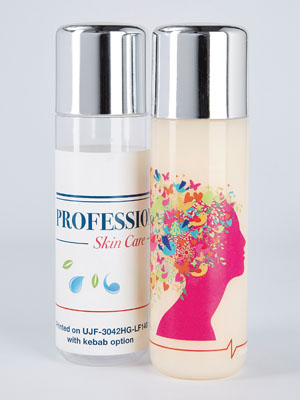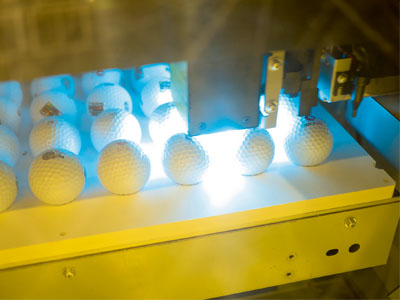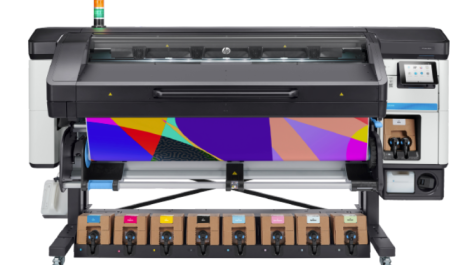Using jigs makes it easy to print many items in one go, such as this Mutoh VJ-426UF printing golf balls
Product decoration promises low entry costs with the potential for good returns. Nessan Cleary looks at the equipment available.
It’s human nature to look for meanings in things, which also translates to buying things that have meaning to us, like a mug with a quote from a well-known film or a pencil case decorated with a figure from Star Wars or even a desk diary with a repeating metallic motif. The point is that printing such decorative effects can greatly increase the value of these objects, and therefore the profit margins for the printer.
In recent years a number of small flatbed printers have appeared to address this market. In some respects these machines are scaled down large format printers, with the same printheads and similar UV-curable inks. However, the smaller machines have an advantage in that they don’t take up much room and are relatively cheap.
Safety in numbers
Stuart Cole, Hybrid Services’ national sales manager for industrial products, says that many customers prefer to buy multiple smaller printers rather than one large format flatbed, noting that ‘people with multiple machines doing lots of little things like badges and having lots of small machines makes it easier to load for small runs and for different production variances.’
Typical applications for these printers can include adding company logos to pens or golf balls or even decorating a keyboard to match a football team’s colours. Most vendors say that it’s not easy to define this market because of the many new applications. UV inks will stick to many different substrates so that just about any wide format flatbed printer can be used for this sort of work.
Mr Cole says that it also includes the trophy engraving market as well as personalised gifts, noting: ‘We can print to wooden clock faces, slate coasters and glass objects. We had a company who printed to the side of model Corgi vans. We have printed to medical applications like pace makers and even colostomy bags.
‘Then there are true industrial products like metals and fascias,’ Mr Cole adds. ‘We have a primer for materials such as polished stainless steel, glass and Perspex.’
What’s available?
Hybrid Services is the UK distributor for Mimaki, which has just launched Mark II versions of its UJF 3042 and 6042 printers that are said to be 20% faster than the older machines. The 3042 has a maximum print area of 300 x 420 mm, while the larger 6042 takes media up to 610 x 420 mm. There is an option, called a Kebab, that allows you to print to a cylindrical item all the way around. It rotates the item and prints onto it. Mimaki also sells a larger model, the UJF 7151plus, which has a print are of 710 x 510 mm and print to objects up to 153 mm thick.

Cylindrical objects can be printed using the Kebab option on Mimaki’s UJF machines
There’s a choice of inksets, depending on the substrates. This includes LH-100, which cures to a very tough finish and can withstand a lot of abrasion but is only suitable for rigid substrates, and LUS-120, which can stretch up to 170% without cracking when pressed or folded, and is suitable for soft material surfaces such as membrane switches or smartphone wallet cases.
Roland has also developed its own desktop printers, including adding a new LEF300 at the start of this year. This is a much larger printer than the existing LEF-12 and LEF-20 printers, covering 770 mm wide by 330 mm long. It can accommodate items up to 100 mm in height and 8 kg in weight. It’s up to 60% faster than the LEF-20, thanks to four print heads combined with two UV-LED lamps for bi-directional printing. Roland has also doubled the number of white and clear (gloss) ink nozzles for faster printing, increased density and opacity and faster build-up of multiple layers for textured effects. The inkset is Roland’s Eco-UV, mostly supplied in 500cc cartridges, with the white in 220cc cartridges.

Roland’s Versa UV LEF-20 is one of threee machines it offers for object printing
Roland also sells the BN20, which is a desktop eco solvent printer that was designed mainly as an entry-level model for the graphics, rather than the industrial, print market. It includes a cutter, making for a complete solution. It takes media up to 515 mm wide, though the cutter only works across a 480 mm width. It can take up to five colours, including the option of white or metallic silver, which can produce some quite striking decorative effects.
Mutoh has two desktop printers. The ValueJet 426UF is mainly aimed at the industrial space for printing to objects like pens and smart phone cases, up to 70 mm thick. It has a print table of 483 x 329 mm and can print onto a range of materials, including aluminium, most plastics and glass. Mutoh has also investigated the option of partnering with other companies to produce jigs to hold specific objects, such as golf balls, in place. Resolution ranges from 360 dpi up to 1440 dpi. It uses UV-LED inks, with the basic configuration being CMYK, which can produce up to 28 beds per hour and there’s an option for adding white and varnish, which cuts the productivity down to 14 beds per hour. However, the six colours add the ability to print to darker objects and to add gloss and spot gloss effects as well as textured effects.
Mutoh also sells the ValueJet 628, a smaller version of its standard eco solvent wide format graphics printers. It takes roll-fed media up to 610mm wide.
In conclusion, all of these printers are relatively inexpensive and offer an effective way to add decorative effects to various items, which can cover everything from added value graphics through to industrial applications.
Read the full issue online here





